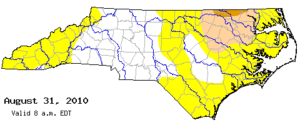By SCOTT MCKIE B.P.
ONE FEATHER STAFF
It’s been a hot summer in Cherokee –one of the hottest and driest on record. Cherokee sits in two counties, Jackson and Swain, which have both been designated as “abnormally dry” by the U.S. Drought Monitor and the N.C. Drought Management Advisory Council.

 The official N.C. Drought report, released Thursday, Sept. 2, states that a total of 55 counties in the state have been given the same designation including other western counties such as Buncombe, Cherokee, Clay, Graham, and Haywood. Twelve counties statewide have been designated as being in a “moderate drought” and Northhampton County has been designated as being in a “severe drought”.
The official N.C. Drought report, released Thursday, Sept. 2, states that a total of 55 counties in the state have been given the same designation including other western counties such as Buncombe, Cherokee, Clay, Graham, and Haywood. Twelve counties statewide have been designated as being in a “moderate drought” and Northhampton County has been designated as being in a “severe drought”.
“It has been dry this summer!” said Sarah McClellan-Welch, EBCI agriculture extension agent. “Growers who had the ability to water have been watering every two to three days. The heat has really made it bad. June, July and August were some of the hottest on record!”
“Farmers and gardeners across Cherokee have reported early tasseling in their corn and the green beans finished really early,” she said. “We hardly had a sweet corn season at all! It dried up in no time. The drought and heat also made the insect population explode. We had terrible damage from potato and bean beetles especially. However, for those who raise hay, the rain came at the right time this year and it was dry enough to get it put up.”
According to the State Climate office of North Carolina, the month of July was the 10th warmest since 1895 and ranks as the 32nd driest on record.
Sheila Hyatt, of Cherokee Water Treatment, related, “I think the most beneficial measure the tribe took in preparation of predicted droughts was the passage of the water conservation ordinance in 2008. This ordinance allows us to enforce restrictions in stages based on drought conditions, anticipated weather forecasts, and most importantly source water levels. It promotes public awareness and conservation practices.”
Kevin Welch, Center for Cherokee Plants, commented, “Due to the weather, there have been a lot of issues with low crop yield which reinforces the need to save seed from season to season! There may also be a need to adjust when crops are planted – it seems that the seasons are off.”
“The heat of summer came earlier, and the spring rains were erratic,” he said. “The fall harvest time is a really good time to evaluate which crops work better in these warmer temperatures and drier conditions. Then, next year’s crops can be planned.”
Susan Young, of N.C. Dept. of Environment and Natural Resources, commented, “An area cannot be considered under a drought without impacts. Right now, agriculture has been adversely impacted in some areas of the state due to the lack of rainfall, although water supplies remain adequate.”
The U.S. Seasonal Drought Outlook, released last month by the U.S. Department of Commerce and the NOAA, shows that drought conditions are “likely to improve” in most of western North Carolina.
“This summer proves how important mulching is to conserve soil moisture in row crops and gardens,” McClellan-Welch related. “If we had the equipment around here for no-till farming, that would have been a good strategy this year. In gardens, anything to cover the soil like straw, pine needles, newspaper, shredded paper, old carpet, cardboard, wood chips, etc. would have helped hold the moisture.”
For more information on droughts and water usage visit: www.savewaternc.org or www.ncdrought.org. For more information on crops, you can contact the EBCI Cooperative Extension Service 554-6935.





